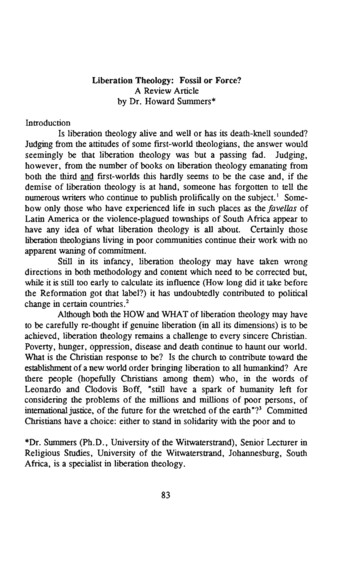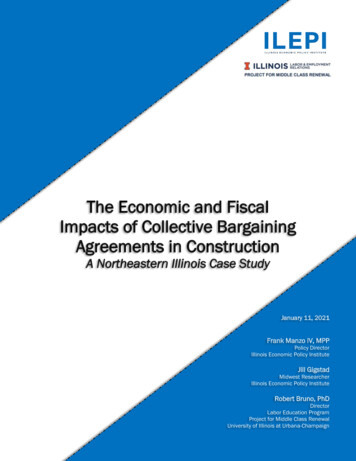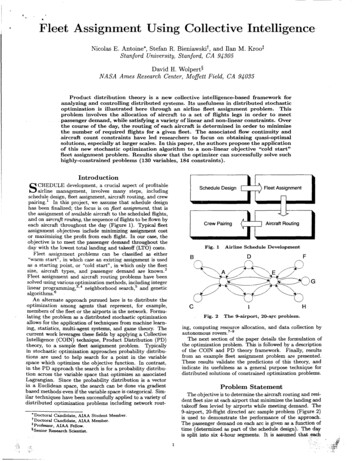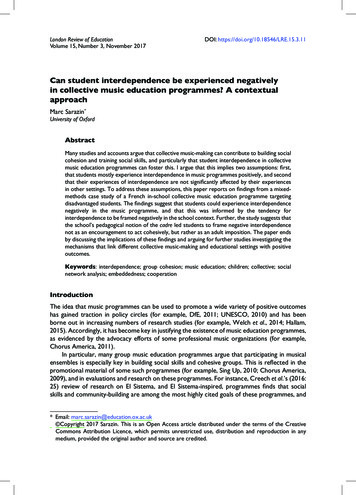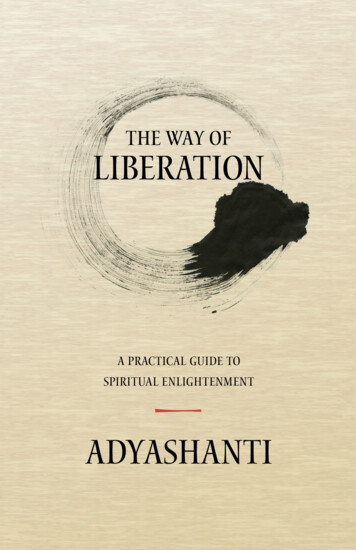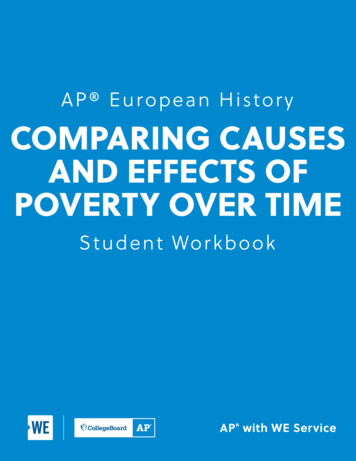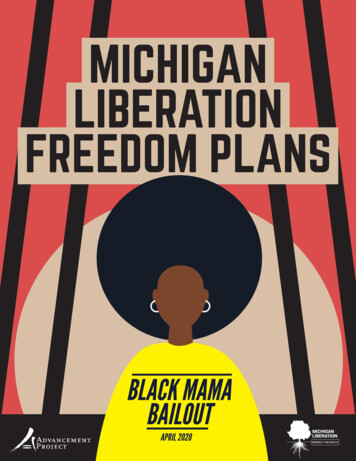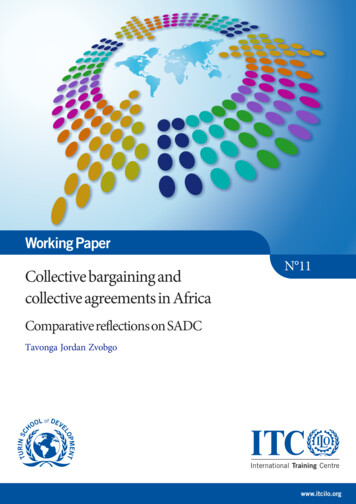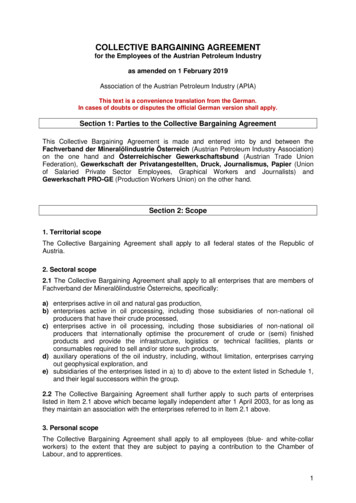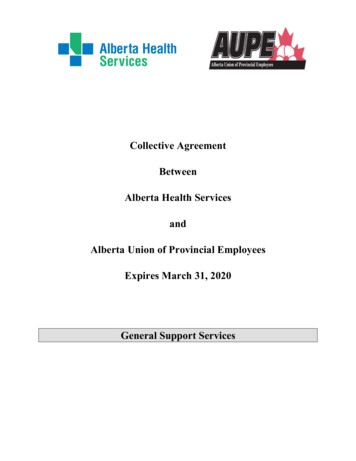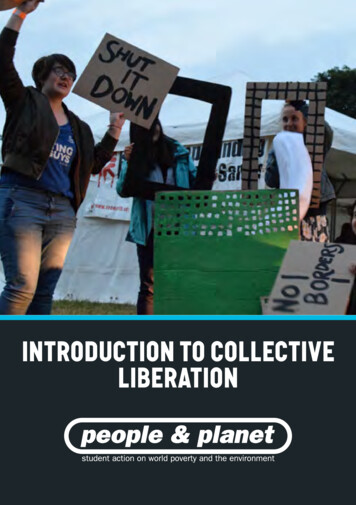
Transcription
introduction to collectiveliberation
what do we mean by collectiveliberation?CONTENTSCollective liberation means recognising that all of our struggles are intimatelyconnected, and that we must work together to create the kind of world we know ispossible. We believe that every person is worthy of dignity and respect, and that withinsystems of oppression everyone suffers.3 What do we mean by collective liberation?Collective Liberation is not just a value, but an action. When we work together acrossthe barriers kept in place to divide us, we strengthen our organising. When combined,our diverse identities and experiences give us the tools to dismantle systems ofeconomic, political and social oppression, and to create a world in which all people areseen as fully human.8 Gender binary & transphobia12 patriarchy24 Social classThis booklet is based on how we understand oppression to manifest today, butunderstanding oppression is a continuing process. We will continually explore and areopen to new ways of understanding how existing institutions and social norms limit ourcapacity to be truly free.28 disabilityWe hope you will join us in understanding and working to end oppression in ourmovements and the world.17 race32 sexuality37 religion40 being an ally42 calling-in43 being intersectional organisers3
what do we mean by collectiveliberation?Oppression & Privilegelevels of oppressionThe societies we are born into have preexisting social and cultural norms thatinfluence our experiences and how weview the world. We are all privileged insome ways and marginalised in others.being denied opportunities or unfairlyevaluated. Wealthier students have agreater chance of being accepted intoprestigious universities because lowerincome students are less prepared, lessencouraged, or less financially able todo so. Oppression and privilege are twosides of the same coin. Understandingboth provides a clearer picture of howsystemic inequality operates, anduncovers more opportunities to interveneto create change.Oppression is deeply embedded in our society because it operates on different levels– individual/personal, systemic/institutional and societal/cultural - with members ofdifferent social groups being advantaged and disadvantaged across these differentlevels.Recognising our own privilege does notmean we should bask in guilt. Instead,recognition is an essential step towardsdismantling systems of oppression. Bybeing open to learning about our ownpatterns of domination and showinga willingness to change these, we cancreate the example that enables othermembers of dominant groups to dolikewise.The Institutional LevelOppression is the experience of repeated,widespread, systemic injustice. Muchoppression is learned through growing upin an unfair world based on centuries ofeconomic, political and social exploitation.While we may not be consciously classist,sexist, racist, homophobic, transphobic,or ableist, it’s inevitable that we learnways of interacting that maintain thestatus quo.Some groups are advantaged becauseother groups are disadvantaged. Peoplefrom privileged groups often benefit atthe expense of people from oppressedgroups. A man is more likely to be hiredor keep his job because women are“When we identify where our privilegeintersects with somebody else's oppression,we'll find our opportunities to make realchange.”Ijeoma Oluo4The individual levelThe individual level includes what individuals believe about themselves and how theyare treated in interpersonal situations by others. Those from disadvantaged groupsmay encounter interpersonal bias or violence, be shunned in social interactions, oroverlooked in group settings. For example, women report that their ideas are ignored ingroup meetings while men are credited when making the same point.The institutional level refers to the policies, laws, and customs enacted bygovernments, companies and social institutions that systematically reflect andproduce inequities. For example, research identifies significant disparities inemployment prospects among UK graduates, with graduates of colour being much lesslikely to be employed than their white peers six months after graduation.The Societal/cultural levelThe societal/cultural level encompasses the norms, values and ideology of thedominant culture that reflect and reinforce the belief that one social group is superiorto another. The dominant group projects its particular way of seeing reality sosuccessfully that it’s view is accepted as common sense, even by those who are in factdisempowered by it. For example, standards of beauty for women are predominatelybased on white norms, with skin and features that are more European being viewedas the perfected standard of beauty. Those who do not posses these attributes mightinternalise oppression by an action such as skin bleaching.Any attempt to dismantle oppression should involve challenging oppression at all thelevels on which it operates.5
what do we mean by collectiveliberation?intersectionalityDifferent forms of oppression do not existby themselves but are shaped by andinteract with all other forms of oppressionand exploitation. For example, a blacktrans-woman might experience sexism,racism, and transphobia. The type ofsexism she experiences will be differentbecause she is black and trans.Privilege is contextual and relational. Forexample, men enjoy more positions ofpower in the world and are at much lowerrisk of experiencing domestic violence.But a white, middle class, gay male wouldexperience a different type of oppressioncompared to a white, working class,heterosexual man. Similarly, black menare often less privileged than white menand experience different types of racismthan brown women, such as heightenedlevels of police targeting and brutality.While we focus on confronting oneform of domination or exploitation in aparticular moment - such as focusing onstate oppression and capitalism when wetalk about austerity - we can interweaveconcepts of oppression based on gender,ability and race when we understand thatpeople of colour, women, and disabledpeople are most impacted by governmentcuts.Divide-and-conquer strategies havebeen prevalent throughout history. We’remade to believe that there’s only so muchfreedom to go around. Working on thebasis of collective liberation gives spacefor each person’s lived experience withoppression to be heard and validated,and to be put in the context of structuralchange that needs to be made.building inclusive spacesGiven the inequality in power, it is often difficult for individuals from marginalisedgroups to openly share their experiences with people from privileged groups for fear ofbeing discounted. It is important to build spaces where all voices are heard, that allowus to operate in social movement spaces that build power beyond repeating forms ofprivilege.We need to let go of the arrogant assumption that our groups are not affected bypower and privilege, or that unaddressed systemic oppression does not affect howwe operate. Being able to identify and label the forms of oppression is the first step tothen envisioning a more just and equitable structure of relations. Also, deepening ourknowledge of how systemic oppression operates allows us to better understand how totransform ourselves and our groups, organisations, and communities.To move to a socially, environmentally, economically and culturally fair alternative, weneed to build mass social movements that include people from every sphere of life. Weneed to build leadership, and take leadership from those most impacted by injustice.Because systems of oppression areinterwoven, they need to be challengedholistically. Different forms of oppressionare able to recreate, reinforce and defendone another. This way of understandingoppression in societies is referred to asintersectionality.67
gender binary & transphobiawhat is the gender binary?what do we mean by gender identity?The gender binary was created by humansociety and is a system that artificiallydivides people into two genders (men andwomen), seen as opposite and distinct.Some cultures understand genderdifferently and describe up to 5 differentgenders.Gender expression changes depending on how people choose to “perform” theirgender, for example through their clothing or behaviour. However, the way a personchooses to perform gender is separate and distinct from how they may define theirgender, which is defined by them alone and may not present itself externally. It’s vitalthat we don’t make assumptions about a person’s gender based on their appearance.It is good practice in group spaces for everybody to share the gender pronouns whichthey use (he, she, they etc.) so that people may be referred to how they wish.The gender binary means that genderis assigned to people based on theirbiological sex, determined by theirgenitalia at birth, and comes alongsidecertain roles in society and culturalmeaning. Privilege is afforded to‘cisgender’ people, whose gender identitymatches the gender they were assignedat birth.Gender and sex are not the same. Whilesex is about the physical effect of yourchromosomes, gender is about howyou feel. Gender is a spectrum withany number of possibilities: people canidentify with being neither a man or awoman, or only one of those, or both ofthem, or anything in between. It’s reallyimportant to understand that a person’sgender is defined by that individual alone.gender glossaryCisgender - umbrella term for people who identify as the gender they were assignedat birth.Transgender – umbrella term for people who don’t identify as the gender they wereassigned at birth.Non-binary- describes any gender identity that does not fit the man-woman binary.Genderqueer – another broad term for people who identify outside of cis gender,maybe no gender, multiple genders, or moving between the genders, meaning howthey identify their gender moves and is more fluid.Trans people’s gender identity often does not align with that which they were assignedat birth. Each trans person will make different choices depending on what’s right forthem. Some might choose to medically and socially transition away from their assignedsex towards their gender identity, while others won’t.Nonbinary people are those that do not identify exclusively as “man” or “woman”.Some identify with neither, both, parts of each, or a fluid and changing mix. Nonbinaryis often considered an umbrella term for many other identities, including genderqueer,agender, and genderfluid.Nonbinary and trans people are diverse. Some may experience body or genderdysphoria, which is a condition that causes physical, mental and/or social discomfort,others don’t. Some may identify as trans as their gender differs from the gender theywere assigned, others don’t. Some may refer to themselves with binary pronouns (heor she), while some will use they or other pronouns like ze/hir or xe/xem.Intersex people are born with genitalia and/or chromosomes that do not conform totraditional XY-male or XX-female characteristics. Though some intersex people aretrans and/or nonbinary, many do not identify that way.Genderfluid – someone who doesn’t identify as two genders simultaneously but adifferent gender depending on what they are feeling.Gender neutral – belonging to neither of the genders within the established genderbinary and doesn’t have a gender prescription89
gender binary & transphobiaWHAT IS CIS PRIVILEGE?The advantages that cisgender people may experience in a society that does notfavour transgender or gender non-confirming people is what we call cis privilege.Cis privilege can manifest itself in a lot of ways. Here are some examples ofcircumstances where a cigender person will not face the barriers that someone who istrans or nonbinary may face: Buying something that requires ID and being challenged on the validity of their ID.Attending family occasions and facing questions or jokes about their genderidentity.Using a gym changing room and being challenged on which changing room theyare using, or else not having a changing room available for their gender.Renting a vehicle and being challenged on the validity of their documents.First encounters with new people and facing anxiety and questions around theirgender identity.Being held in a detention centre or prison and being held in a space which isdesigned for people of a different gender.Filling out forms and not having their gender recognised in the documentation.Flirting with someone you haven’t met before and facing anxiety and questionsaround their gender identity.Shopping for clothes, shoes or accessories and either being questioned abouttheir purchases or else finding difficulties acquiring what is needed.Oh no. I used the wrong pronounMake a conscious effort to use people’s correct gender pronouns. But if you don’t,make sure to correct yourself, briefly apologise, and don’t make a big deal out of it(you risk centering yourself and your own embarrassment if you do).10what does transphobic oppressionlook like?Content warning: This section includes reference to violence and suicideOppression of trans and nonbinarypeople resulting from a constructedgender binary has clear impacts on transand nonbinary people’s lives. 38% oftrans people have experienced physicalintimidation and threats, and 81% haveexperienced silent harassment suchas being stared at or whispered about.One in every twenty trans people havebeen physically assaulted at work.Between 2008 and 2014, there were 1,612trans people were murdered across 62countries – that’s to one every two days.These experiences have a wider impacton the lives of trans people. Nearlyhalf of trans people who are not livingpermanently “out” in their preferredgender stated they are prevented fromdoing so because they fear it mightthreaten their employment status. 59%of trans youth said they had deliberatelyhurt themselves, compared with 8.9%of all 16- to 24-year-olds. 48% of transpeople under 26 attempt suicide and 59per cent have contemplated suicide.How can this relate to other formsof oppression?Every trans or non-binary person’s experience is specific and unique to them andsomeone’s individual experience of oppression can also be additionally affected byrace, class, disability, sexuality and immigration status. For example, the experienceof a trans person seeking gender reassignment surgery will differ on grounds oftheir economics status and their ability to access expensive private health care.Trans women of colour are even more likely to experience violence and hate crimesthan white trans counterparts. Recognising the way in which the gender binary canintersect with and multiply other forms of oppression is crucial to begin unpicking it.11
patriarchyWHAT IS patriarchy?Patriarchy is a system of unequal power relations that gives men privileges in all areasof their lives — social, economic, institutional, cultural, political, and spiritual — whilewomen and gender non-conforming people are systemically disadvantaged.Though patriarchy affects women much more severely, it distorts the humanity of allgenders and reduces our ability to be in kinship with one another. Like all other unjustand arbitrary systems of authority and power, patriarchy must be actively challengedin our organising if we are to achieve collective liberation. “Patriarchy has no gender,”thus it’s going to take all people to dismantle it.“Patriarchy is a political-social systemthat insists that males are inherentlydominating, superior to everything andeveryone deemed weak, especially females,and endowed with the right to dominateand rule over the weak and to maintainthat dominance through various forms ofpsychological terrorism and violence.”bell hookswhat does patriarchal oppressionlook like?Content warning: This section contains reference to domestic and sexual violenceIn the UK women on average earnsignificantly less than men. The genderpay gap is currently 13.9% for full timeemployees and 18% including part timeemployees. Reasons for this include thatwomen make up a larger portion of lowerpaid roles, ‘feminised’ sectors such ascare and leisure are undervalued, andthat most senior positions are held bymen.On average, women do 66 hours a weekof unpaid labour (such as childcare,cleaning, and cooking) whereas men do16 hours a week. For women on maternityleave, this figure rises to 60 hours perweek. 54,000 women leave their job earlyevery year due to their treatment afterhaving a baby.Men hold most of the powerful positionsin society. 71% of members of the UKparliament are men and 95% of the ChiefExecutives in the top 100 UK companiesare men.In England and Wales, 2 women arekilled every week by a partner or formerpartner, and 1 in 4 women will experiencedomestic violence in their lifetimes. Policein the UK receive a domestic assistancecall once per minute, but on average awoman is assaulted 35 times before herfirst call to the police.1 in 5 women aged 16-59 in England andWales have experienced some form ofsexual violence since the age of 16. Onlyaround 15% of those who experiencesexual violence choose to report to thepolice, and only around 1 in 20 rape casesend in a conviction. While men alsoexperience domestic and sexual violence,in England and Wales 81% of domesticviolence victims and survivors and 88% ofpeople who are raped are women.Sources: Office for National Statistics, www.parliament.uk.1213
patriarchyHow can this relate to other formsof oppression?Patriarchy doesn’t exist in isolation fromother forms of oppression, it intersectsand exacerbates oppressive experiences.Women of colour experience genderedracism. Movements to ban burqas orother forms of cultural or religiousdress target Islamic women, utilisingreligious discrimination and oppressionto police women’s bodies and what theychoose to wear. Lesbian and bisexualwomen experience a specific form ofsexualisation and fetishisation in popularculture. Disabled men face a pay gapof 11% with non-disabled men, whereasdisabled women face a pay gap of 22% twice as high.why should our group think aboutpatriarchy?Sexism often remains unaddressedwithin activist groups. Although somemen feel they are not capable of sexism,simply believing in gender equalitydoes not erase male privilege. Workingwith progressive men can have its ownfrustrations as they may feel they are notguilty of sexism – often because of thelack of intention to be sexist – withouttruly analysing their actions within aframework of dominance.14Addressing patriarchy in our movementsis not about guilt or blame, it is about alifelong learning process to effectivelyand humbly confront oppression. Sincepatriarchy pervades society, it is nosurprise that it also pervades socialmovements. If we want to challengepatriarchy, we must understand how ouractions and assumptions are influencedby the prevalence of sexism in ourconsciousness and social relations.five key ways patriarchy can manifest in socialmovements12345Women face an uphill battle to prove their intelligence and commitmentas political activists. Men are more readily perceived as experts, whereaswomen have to struggle a lot harder to prove their capabilities, theirunderstanding of political issues, and be taken seriously as committedorganisers, researchers, journalists and writers.Meetings are dominated by male speakers and leaders, while secretarialwork, cooking, childcare, and the emotional labour of supporting communitywell-being are largely borne by women. This gendered division of labour is afrequently reproduced patriarchal pattern.Women continue to be sexually objectified. Women of colour and femmewomen in particular are fetishised, obscuring the dynamics of racism,fatphobia, and ableism behind “personal preferences.”Sexist comments or incidents can leave women and gender non-conformingpeople feeling humiliated, angry or upset, yet such comments are too oftendismissed as harmless. Women discussing sexism can be accused of overreacting, and women’s concerns are belittled unless validated by other men.Feminism is not seen as central to campaigning and collective struggle.Instead it is relegated to a special-interest issue. This results in thetrivialisation of women’s issues, particularly violence against women andreproductive justice.15
patriarchyRACETHINGS TO THINK ABOUT IN YOUR GROUPRace is a socially constructedclassification of people that is not basedon biological truth. There is no geneor cluster of genes shared by all blackpeople or all white people. Instead, racialdifference is something humans havecreated for a social and political purpose. Do you make assumptions about people’s gender based on the clothes they wearor how the choose to present themselves?When a trans or non-binary person is speaking, are all members actively listening?How much of the logistical planning work in your group is undertaken by women /non-binary people?How much of the cooking and cleaning in your groups is undertaken by women /non-binary people?Do the same few men tend to dominate discussions? The facilitator or others inthe meeting should consider suggesting a go-round to get more people talking. Ifyou are one of those men, be aware of the space you take up.Create an atmosphere that is empowering, especially to new women in the group.Share skills and knowledge in a non-paternalistic manner to build the leadership ofwomen, especially women of colour.Realise that something can be hurtful even if you personally don’t find it offensive.Realise that sexism, in various forms, runs deep and always plays itself out. Don’ttrivialise women’s issues or place the sole responsibility for fighting oppression onthe oppressed.Understand that it’s not just about representation - the fact that a group isdominated by men might be a symptom and not the problem itself. To avoidtokenism, make sure your group gives equal consideration to women’s/trans/nonbinary voices in a meaningful manner.EXTRA RESOURCESVideo: Sex, Gender, and Expanding the Identity identity-box/Comic: What If We Thought Of Gender Like Ice Cream? It Makes Sense, Here’s kinda-like-ice-cream/Article: 10 Myths About Non-Binary People It’s Time to binary-peopleVideo: Why Pronouns Matter For Trans Peoplewww.youtube.com/watch?v N yBGQqg7kMVideo: What is Social Reproduction? An introduction by Plan ial-reproduction/16Europe’s history of colonialism isfundamental to the modern constructionsof race, establishing the relationship ofdomination and subordination. Race as aclassification of human beings served thepurpose of legitimising the dominance ofwhite people over non-white people.Britain’s justification for the colonialproject was famously expressed byRudyard Kipling, winner of the 1907 NobelPrize for Literature, in his 1899 poem, “TheWhite Man’s Burden.” The poem says it isa moral responsibility to rule over peoplewho were “half-devil and half child” whotherefore needed the discipline, andgovernance that only a “superior” racecould provide.In the 1950s, the United Nations Educational, Scientific and Cultural Organisation(UNESCO) issued a statement asserting that all humans belong to the same speciesand that “race” is not a biological reality but a myth. But while it may not be a biologicalreality, the concept of human races is very much real.“White supremacy is an historically based,institutionally perpetuated system ofexploitation and oppression of continents,nations, and peoples of colour by whitepeoples and nations of the Europeancontinent, for the purpose of maintainingand defending a system of wealth, powerand privilege.”COLOURSOFRESISTANCE.ORG17
RACERACISMRacism is a set of implicit or explicit beliefs, false assumptions, and actions thatsuppose the inherent superiority of one racial group over another.Even if you do not perceive yourself to be racist, your life is affected by this structure.We are born into a racist society. Racism is a part of our everyday lives. Where youlive, where you go to school, your job, your profession, who you interact with, howpeople interact with you, your treatment in the healthcare and justice systems are allaffected by your race. Today, Black and brown people face harassment, are under andunemployed, over-policed, imprisoned, murdered and displaced from their homes bygentrification, climate change and global capitalism.cultural appropriationCultural appropriation is the practice of taking intellectual property, traditionalknowledge, cultural expressions, or artefacts from another culture without permission.As the UK is made up of diverse ethnicities, it’s unsurprising that people pick updialects, customs and traditions of the cultural groups that surround them. However,cultural appropriation is different to this, and has little to do with one’s exposure todifferent cultures. Instead, cultural appropriation involves members of a dominantgroup exploiting culture of less privileged groups, often with little understanding of theroots of such culture and the challenges those who created it faced.Cultural appropriation can contribute to racial oppression by denigrating a particularculture whilst mimicking it for personal gain. For example, when white person saysthat they grew dreadlocks so they aren’t perceived as the ‘pretty one’ - connectingdreadlocks with the opposite of ‘pretty.’ White celebrities are often criticised foradopting elements of black culture because they are trendy, whilst failing to speak upabout racism or even to acknowledge that they have profited from a style of clothing ormusic that was developed by black people.Even when meant with the best of intent, white people adopting an item closelyconnected to a particular culture can be insensitive to the experiences of people ofcolour. For example, a white person may wear an item such as a bindi as a fashionstatement, without realising that South Asian immigrant communities are oftendenigrated or stigmatised for wearing these items that are part of their culture.18WHAT DOES RACIST OPPRESSION LOOK LIKE?Institutional racism in the UK manifestsacross different areas of life. Forexample, in April 2018 The Independentrevealed that black students applying touniversity are 21 times more likely to havetheir applications investigated for falseor missing information than their whitecounterparts.A report by HM Inspectorate ofConstabulary found that in 2016/17, blackpeople were at least eight times morelikely than white people to be stoppedand searched by the police, even thoughit is statistically less likely for drugs tobe found. Black people make 12% of theprison population in England and Waleseven though they make up just 3% of thepopulation.In 2017 the TUC found that Black andMinority Ethnic (BAME) groups arepersistently disadvantaged in thelabour market. Overall, employmentrates for white people (76.1 percent) aresignificantly higher than for those from aminority ethnic group (64.2 percent).Their research also showed that thegrowth of insecure work has made racialinequalities worse. BAME workers aremore likely to be in insecure jobs such aszero-hours contracts.On a global scale, former coloniescontinue to be exploited, and thisexploitation enriches shareholders oflarge corporations predominantly basedin the Global North. They benefit fromnatural resources which are exploitedthrough mining and extraction as well asland grabs. They also profit from peoplein the Global South in oppressive workingconditions.Souces: tuc.org.uk, independent.co.uk“I feel that if we don't take seriouslythe ways in which racism is embedded instructures of institutions, if we assumethat there must be an identifiable racistwho is the perpetrator, then we won't eversucceed in eradicating racism.”Angela Davis19
RACEhow do we prevent racism in ourgroup?White privilege can be a barrier to antiracist movement building – for example,when white people organise actions thatinvolve possible arrest without thinkingabout how people of colour are treateddifferently by the police, and often havehad experiences of police brutality.People with white privilege haveinternalised the idea of whiteness as thenorm and non-whiteness as ‘other’. Todeconstruct white privilege, you will needto listen to others and let go of the ideathat your way of organising is the best oronly way.Confronting white privilege requiresopenly challenging the dynamics ofprivilege in our groups, and creatingforums for addressing oppression.Notice who holds power. Study effectivefacilitation and group dynamics to fostermore democratic processes.Ensure racism is not denied, minimised orjustified. Deracialising an issue restrictsthe self-determination of the people whoare most impacted by that issue to bedefining their own struggle.Build a process for addressing disputeswithin your groups, and confronteveryday racism in yourself, in yourcommunities and campaigns in a way thatdoes not shame people.Those impacted by racism have thebest understanding of how to addressit. People of colour have been leadinganti-racist organising for decades, so it’simportant to look to their leadership andexperience.“how can we get people of colour into ourgroup?”. Wrong Question!We should not aim to “get” people of colour to join “our” groups. The right question is,“How can we be anti-racist activists dedicated to bringing down white supremacy?”Too often we talk about why more people of colour aren’t in the group or the need to“reach out” to people of colour to “diversify” our movement. But multiracial doesn’tautomatically mean anti-racist. Instead of looking to “recruit” in order to increasediversity, we need to make anti-oppressive groups that people of colour will want to/are willing to join (and stay in).20using our privilegeGuilt doesn’t help anyone, and it frequently just inspires navel-g
likely to be employed than their white peers six months after graduation. the Societal/cultural level The societal/cultural level encompasses the norms, values and ideology of the dominant culture that reflect and reinforce the belief that one social group is superior to another. The dominant group projects its particular way of seeing reality so
